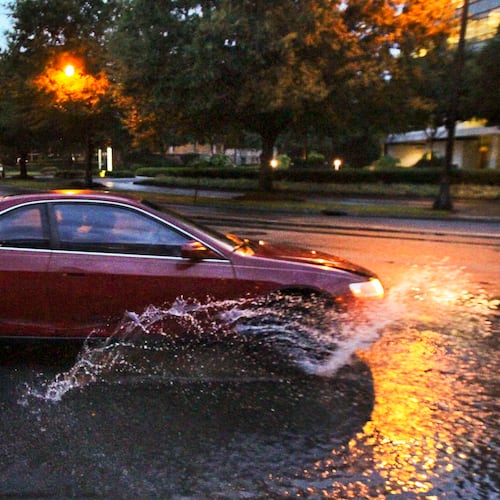Tucker city leaders may soon decide the fate of a Chick-fil-A that’s tried for more than a year to relocate down the street to expand its size and drive-thru.
The popular fast-food chain has been met with relentless opposition during the entire process, leading to overhauled plans and revamped designs. The restaurant’s latest attempt to move a quarter mile along Hugh Howell Road has been met with equal pushback from residents, city staff members and the city’s Planning Commission, which recommended the project’s denial at its most recent meeting.
The restaurant’s representatives argue the relocation will increase property values and attract other businesses to the corridor, which runs alongside multiple residential streets. They also said the drive-thru will not gridlock traffic or encumber nearby homeowners, a claim that received significant pushback.
“This intersection does not work with the traffic it currently has,” resident Tom Lawrence said during last Thursday’s Planning Commission meeting. “Please don’t compound it with additional traffic.”
Bridgette Ganter, a Chick-fil-A engineer, went over the results of a traffic study during the meeting, admitting that the area’s intersections are busy but that Chick-fil-A’s addition wouldn’t make things worse.
“(The traffic study) is not saying that Chick-fil-A is going to make it better,” she said. “It’s just not going to make it worse. It’s already pretty bad.”
Rebuild or relocate
Chick-fil-A has been trying to move its Hugh Howell Road location for several years, and the company began pursuing a plan to relocate a quarter mile away in early 2021.
The restaurant is currently in the center of one of the city’s busiest thoroughfares, where Hugh Howell Road meets Lawrenceville Highway. Chick-fil-A representative Jennifer Santelli said during a May 9 council meeting that the location is 33 years old and would need to be torn down and rebuilt into a drive-thru only restaurant to remain viable.
The company’s plan is to move to 4435 Hugh Howell Road and transform a Presbyterian Church and shuttered BBQ joint into a nearly 5,000-square-foot Chick-fil-A with a three-lane drive-thru that connects to Rosser Terrace, a residential street.
The relocation requires a special land use permit along with four variances, since drive-thrus are not allowed on those parcels. Santelli argued that multiple variance requests are not a sign that the project is doomed to fail or mess up the city’s plans for the area.
“Variances don’t mean that this is the wrong location for (this) proposed use,” she said May 9. “It simply means that the black-and-white ordinance can’t take into account all of the various considerations that we put into planning a site plan…. We’ve just found the most functional and least impactful site plan possible, and the zoning ordinance simply couldn’t account for everything.”
Residents argue the City Council shouldn’t ignore its city code and allow the company’s plans to move forward. Robert Jenkins, who lives nearby, said the drawn-out process and multiple redesigns show the company’s plans are flawed at their core.
“This is an attempt to make a square peg fit into a round hole. And while their drafters keep whittling and sanding away at the edges of that peg, it’s still not round, and it’s still not going to fit,” he said May 9. “The fact that we’ve been having the same conversation for about a year should be evidence enough that it’s not working.”
Development boon or traffic woes?
During last week’s planning commission meeting, Ganter said Chick-fil-A’s latest plan is well-designed, would minimize traffic impacts and add extra road infrastructure to the area, including a bypass lane.
The traffic study showed the company’s relocation would generate an additional 1,800 trips in the area, but Ganter said that each customer would count as two trips, since they’re driving to pick up their food and driving to leave.
“The Chick-fil-A that we’ve proposed is efficient, it’s more than adequate, especially with the added bypass lane. There’s adequate parking,” she said. “It’s designed well to move vehicles in and out and also to contain all vehicles parked or going through the drive-thru on site.”
Credit: City of Tucker
Credit: City of Tucker
She also argued all of those additional trips would be spread out throughout the day, arguing that the high number can be misleading. The traffic study, which was conducted by Bowman in early May, determined the proposed Chick-fil-A would not “adversely impact the surrounding roadway network” while finding that it would still contribute to the area’s congestion.
Residents said it’s already a challenge to drive in the corridor during peak travel times, and nothing from the traffic study dissuaded those concerns. Nicole Basden, a resident, also argued that a drive-thru as busy as Chick-fil-A’s does not belong on the edge of residential neighborhoods.
“Whenever they (Chick-fil-A) do pictures and drawings, they never show you that someone’s house is going to be literally next door to the drive-thru,” she said. “Or that there’s a trampoline with kids at homes right across the street from the entrance to this Chick-fil-A.”
Not many Tucker residents have spoken for the project during recent public meetings, but Mark Kelly spoke multiple times in favor of the relocation May 9. The Smoke Rise neighborhood resident argued Chick-fil-A will boost business in the area and attract other retailers and restaurants.
“I’m worried about that corridor because there’s a lot of vacant buildings,” he said. “... It’s in need of successful business, and I know of no business more successful than Chick-fil-A.”
Planning Commission member Seth Burrows was absent from last week’s meeting, but the rest of the board voted 6-0 to recommend the project’s denial. The planning commission only makes recommendations, and the City Council will likely vote on the permit application at their next meeting June 13. Mayor Frank Auman said the lengthy project needs to reach a conclusion.
“We need to press on to some kind of a decision for everybody’s sake,” he said May 9.
About the Author
The Latest
Featured

